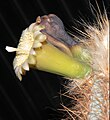
Arthrocereus melanurus is a species of plant in the family Cactaceae. It is endemic to Brazil. Its natural habitats are dry savanna and rocky areas. It is threatened largely by habitat loss.

Mirabella minensis, synonym Cereus mirabella, is a species of plant in the family Cactaceae. It is endemic to Brazil. Its natural habitat is dry savanna. It is threatened by habitat loss.

Facheiroa cephaliomelana is a species of plant in the family Cactaceae.
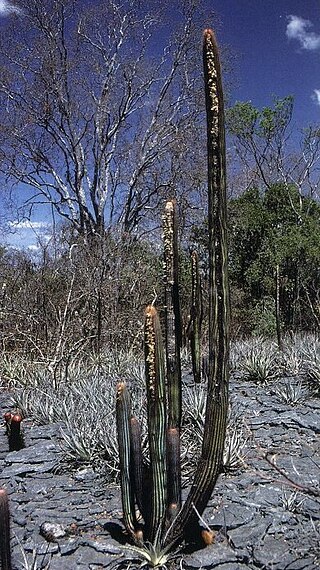
Micranthocereus dolichospermaticus is a species of plant in the family Cactaceae. It is endemic to Brazil, where it is confined to the states of Bahia and Minas Gerais. Its natural habitat is rocky areas. It is threatened by habitat loss.
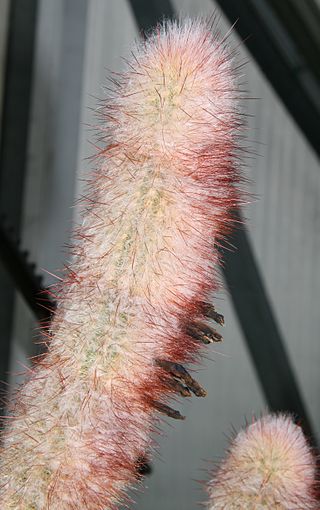
Micranthocereus violaciflorus is a species of plant in the family Cactaceae. It is endemic to Brazil.

Rhipsalis pilocarpa, the hairy-fruited wickerware cactus, is a species of flowering plant in the cactus family that is endemic to Brazil. Scarce in the wild, it is known only in a small number of isolated locations. Its status is listed as "vulnerable" by the IUCN Red List. However, it is cultivated as an ornamental houseplant and as such has gained the Royal Horticultural Society's Award of Garden Merit.

Uebelmannia buiningii is a species of plant in the family Cactaceae. It is endemic to Brazil. Its natural habitat is dry savanna. It is threatened by habitat loss.

Uebelmannia gummifera is a species of plant in the family Cactaceae. It is endemic to Brazil. Its natural habitat is dry savanna. It is threatened by habitat loss.

Uebelmannia pectinifera is a species of plant in the family Cactaceae. It is endemic to Brazil. Its natural habitats are dry savanna and rocky areas. It is threatened by habitat loss.

Cipocereus bradei is a species of cactus. It is endemic to the state of Minas Gerais in Brazil. It is threatened by habitat loss.

Cereus jamacaru, known as mandacaru or cardeiro, is a cactus native to central and eastern Brazil. It often grows up to 6 metres high.
Frailea gracillima is a species of Frailea from Brazil, Paraguay, and Uruguay.

Praecereus euchlorus is a flowering plant in the family Cactaceae that is found in Brazil, Bolivia and Paraguay at elevations of 700 to 1300 meters

Cereus phatnospermus, synonym Cereus kroenleinii, is a species of columnar cactus found in Brazil, Bolivia, and Paraguay.
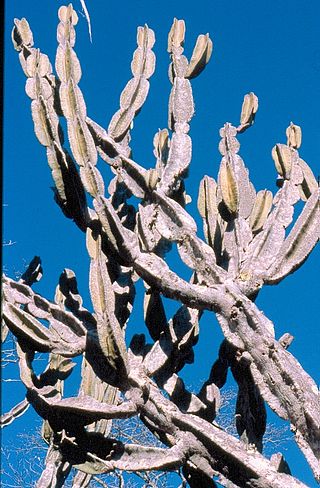
Cereus pierre-braunianus is a species of columnar cactus found in NE Goiás in Brazil.

Mirabella estevesii, synonym Cereus estevesii, is a species of columnar cactus found in Minas Gerais, Brazil. The first description was published in 2004 by Pierre Josef Braun as Cereus estevesii.
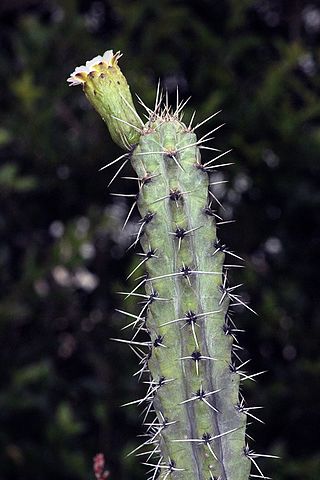
Xiquexique tuberculatus is a plant species in the genus Xiquexique from the cactus family. It is commonly called "Caxacubri".

Xiquexique gounellei is a species of plant in the genus Xiquexique of the cactus family. Common names include "Alastrado", "Chique-Chique", "Xique-Xique" and "Xique-Xique das Pedras".

Melocactus bahiensis is a species of Melocactus found in Bahia, Brazil.

Cipocereus crassisepalus is a species of cactus endemic to the state of Minas Gerais in Brazil.




